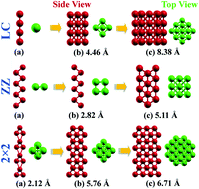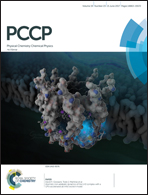Modeling of diameter-dependent Fe and Co ultrathin nanowires from first-principles calculations†
Abstract
We present the electronic, magnetic, thermoelectric and optical properties of ferromagnetic metal nanowires (NWs) made of iron (Fe) and cobalt (Co) atoms using a first principles approach. Each property has been investigated as a function of atomic arrangement and nanowire diameter. Magnetic anisotropy is predicted originating from the spin–orbit coupling. Significant delocalization of electronic charge density is found in Fe nanowires with the increase in nanowire diameter, while the charge distribution anisotropy manifests in all the studied nanowire configurations. The thermoelectric properties exhibit strong coupling to the nanowire configuration and diameter. Thermal conductivity shows large divergence from the bulk iron and cobalt. The optical properties show the strongest increase for nanowires with large diameters. The theoretical modeling of configuration- and diameter-dependent nanowire properties serves as a cornerstone for future utilization of nanowire films in a variety of applications.



 Please wait while we load your content...
Please wait while we load your content...